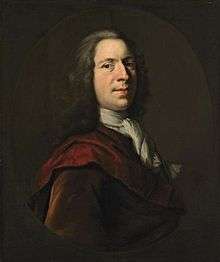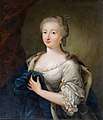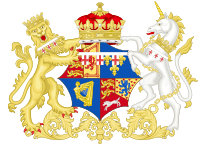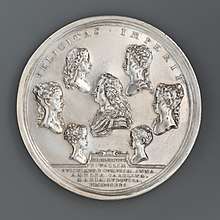Anne, Princess Royal and Princess of Orange
| Anne | |
|---|---|
| Princess Royal | |
 | |
| Princess consort of Orange | |
| Tenure | 1734–1751 |
| Born |
2 November 1709 (New Style) Herrenhausen Palace, Hanover |
| Died |
12 January 1759 (aged 49) The Hague |
| Burial |
23 February 1759 Nieuwe Kerk, Delft |
| Spouse | William IV, Prince of Orange |
| Issue |
Carolina, Princess of Nassau-Weilburg Princess Anna William V, Prince of Orange |
| House | Hanover |
| Father | George II of Great Britain |
| Mother | Caroline of Ansbach |
Anne, Princess Royal and Princess of Orange (2 November 1709 – 12 January 1759) was the second child and eldest daughter of King George II of Great Britain and his consort Caroline of Ansbach. She was the spouse of William IV, Prince of Orange, the first hereditary stadtholder of all seven provinces of the Northern Netherlands. She was Regent of the Netherlands from 1751 until her death in 1759, exercising extensive powers on behalf of her son William V. She was known as an Anglophile, due to her English upbringing and family connections, but was unable to convince the Dutch Republic to enter the Seven Years' War on the side of the British. Princess Anne was the second daughter of a British sovereign to hold the title Princess Royal. In the Netherlands she was sometimes known as Anna van Hannover.
Early life
Anne was born at Herrenhausen Palace, Hanover, five years before her paternal grandfather, Elector George Louis, succeeded to the thrones of Great Britain and Ireland as George I. She was christened shortly after her birth at Herrenhausen Palace.[1] She was named after her paternal grandfather's second cousin Anne, Queen of Great Britain.[2]
She learned German, French and English,[3] and was taught music (including singing, harpsichord, and composition) by Georg Friedrich Händel. Händel did not like teaching, but said he would "make the only exception for Anne, flower of princesses".[4] She remained a lifelong supporter, attending his operas and subscribing to his music.[5]
Anne contracted and survived smallpox in 1720,[6] and two years later her mother helped to popularise the practice of variolation (an early type of immunisation against smallpox), which had been witnessed by Lady Mary Wortley Montagu and Charles Maitland in Constantinople. At the direction of Caroline, six prisoners condemned to death were offered the chance to undergo variolation instead of execution: they all survived, as did six orphan children given the same treatment as a further test. Convinced of its medical value, the Queen had her two younger daughters, Amelia and Caroline, inoculated successfully.[7] Anne's face was scarred by the disease, and she was not considered as pretty as her two younger sisters.[8]
On 30 August 1727, George II created his eldest daughter Princess Royal, a title which had fallen from use since its creation by Charles I for his daughter Mary, Princess of Orange in 1642.
Princess of Orange
A potential marriage contract between Anne and King Louis XV of France was eventually discarded when the French insisted that Anne must convert to Roman Catholicism.[3] On 25 March 1734 (New Style) in the Chapel Royal at St. James's Palace, she married William IV, Prince of Orange.[9] She then ceased to use her British title in favour of the new one she gained by marriage. The music played at her wedding, This is the day was set by Handel to the princess's own words based on Psalms 45 and 118.[10] Handel also composed an operatic entertainment, Parnasso in Festa, in honour of her wedding which was performed for the first time at the King's Theatre, London, on 13 March 1734, with great success.[11]
William suffered from a spinal deformity, which affected his appearance, but Anne said she would marry him even "if he were a baboon".[12] Her reason for being so insistent upon this marriage was reported to be simply that she wished to be married, to avoid a life as a spinster at the court of her father and her brother, with whom she did not get along; and as the only match considered suitable for her was with a monarch or heir to a throne, William was essentially her only remaining Protestant choice, and when questioned by her father, she stated that it was not a matter of whether she should marry William, the question was rather whether she should marry at all.[13] She quarreled with her brother, the Prince of Wales, about her choice.
William and Anne sailed to Holland after a honeymoon at Kew. In the Netherlands, they resided at Leeuwarden. Anne soon felt homesick when William went on campaign in the Rhineland, and she travelled back to England, believing herself to be pregnant, with the motivation that as her child would be in succession to the thrones of Britain and Ireland it should be born in Great Britain.[14] However, this decision caused conflict with her husband and her father, who both commanded her to return to Holland after a brief stay.[15] By April 1735, it was clear that Anne was not with child after all.[16] In 1736, she did become pregnant, but the child (a daughter) was stillborn.[17]
Anne was not well liked by the people of the Netherlands and did not get on well with her mother-in-law.[18] She was perceived as haughty, with a belief in British superiority over the Dutch; she appeared to isolate herself with her interests in music and literature; and she was accused of displaying little consideration for her courtiers, for example by forcing her ladies-in-waiting to read for her for hours, ignoring their fatigue.[13] Her relationship with William, however, which was at first distant, eventually developed into harmony and intimacy, which is displayed in their correspondence.[19] In 1747, William became Stadtholder of all the Seven United Provinces, and this was followed by a constitutional reform which made his new wider authority hereditary.[18] William and Anne moved to the Hague, where Anne introduced Händel to the Netherlands: he accepted her invitation to her music life at the Hague in 1750.[20] The composer Josina van Aerssen was one of her ladies-in-waiting.
Regency
William IV died on 22 October 1751, at the age of forty, and Anne was appointed as regent for her three-year-old son, William V. She gained all the prerogatives normally held by a hereditary Stadtholder of the Netherlands, with the exception of the military duties of the office, which were entrusted to Duke Louis Ernest of Brunswick-Lüneburg.[20] She was hard-working, but arrogant and imperious, which made her unpopular.[21] The 1750s were years of increasing tension and commercial rivalry between Holland and Great Britain, which placed her in a difficult position.[22]
Anne's interior policy focused on defending the authority of the central hereditary Stadtholder government over the traditional rights of the Dutch states.[18] The reform of the hereditary post of Stadtholder had been introduced during the reign of her late husband; it was new and controversial and was questioned after his death, but Anne effectively defended the centralized government.[20] In the conflict with the city of Haarlem, for example, she prevented the city from holding its election by refusing the release of its list of candidates.[20] Her harsh rule was resented, but her consolidation policy effectively secured the new hereditary Stadtholder rule in the Netherlands.[20]
In her foreign policy, Anne favored the British alliance with the Emperor before the French, a policy which was not popular in the Netherlands, and her fortification of the southern provinces against the French Netherlands was met with great opposition.[20]
Anne continued to act as regent until her death from dropsy in 1759, at The Hague, when she was replaced by her mother-in-law, Marie Louise of Hesse-Kassel, who was assisted by Duke Louis Ernest of Brunswick-Lüneburg. When she too died in 1765, Anne's daughter, Carolina, was made regent until William V would reach the age of eighteen in 1766.
Works
The princess took drawing and painting lessons from Herman van der Mijn and made a self-portrait in 1740 that is in the collection of the House of Orange-Nassau Historic Collections Trust. She also made a portrait of Mijn himself while he was at work making portraits of other family members.[23]
 Portrait of Herman van der Mijn by Anna van Hannover
Portrait of Herman van der Mijn by Anna van Hannover Self-portrait of Anna van Hannover in 1740
Self-portrait of Anna van Hannover in 1740
Legacy
Princess Anne, Maryland is named for her, as is Fort Ann, New York.
Arms
On 31 January 1719, as a grandchild of the sovereign, Anne was granted use of the arms of the realm, differenced by a label argent of five points, each bearing a cross gules. On 30 August 1727, as a child of the sovereign, Anne's difference changed to a label argent of three points, each bearing a cross gules.[24]
 |
|---|
Issue
| Name | Birth | Death | Notes |
|---|---|---|---|
| Princess Carolina | 28 February 1743 | 6 May 1787 | married 1760, Charles Christian, Prince of Nassau-Weilburg; had issue |
| Princess Anna | 15 November 1746 | 29 December 1746 | |
| William V, Prince of Orange | 8 March 1748 | 9 April 1806 | married, 1767, Princess Wilhelmina of Prussia; had issue |
Ancestors
References
- ↑ "Yvonne's Royalty Home Page: Royal Christenings".
- ↑ Van der Kiste, p. 24
- 1 2 Van der Kiste, p. 84
- ↑ Van der Kiste, p. 85
- ↑ Vickers, David. "Programme Notes for "Parnasso in Festa"". Retrieved 17 May 2014.
- ↑ Van der Kiste, p. 73
- ↑ Van der Kiste, p. 83
- ↑ Van der Kiste, p. 78
- ↑ Van der Kiste, p. 132
- ↑ Van der Kiste, p. 133
- ↑ Lang, Paul Henry (2011). George Frideric Handel (reprint ed.). Dover Books on Music. pp. 249–50. ISBN 978-0-486-29227-4.
- ↑ Van der Kiste, p. 131
- 1 2 John Van der Kiste, The Georgian Princesses
- ↑ djr (20 March 2017). "Digitaal Vrouwenlexicon van Nederland". Retrieved January 13, 2014.
- ↑ Van der Kiste, pp. 135–136
- ↑ Van der Kiste, p. 136
- ↑ Van der Kiste, p. 150
- 1 2 3 djr (20 March 2017). "Digitaal Vrouwenlexicon van Nederland". Retrieved January 13, 2014.
- ↑ djr (20 March 2017). "Digitaal Vrouwenlexicon van Nederland". Retrieved January 13, 2014.
- 1 2 3 4 5 6 djr (20 March 2017). "Digitaal Vrouwenlexicon van Nederland". Retrieved January 13, 2014.
- ↑ Van der Kiste, p. 198
- ↑ Van der Kiste, p. 209
- ↑ Clayton, Ellen Creathorne. English female artists, volume 2 (London, Tinsley brothers, 1876) p. 81 ff.
- ↑ Velde, Francois R. "marks of cadency in the British royal family".
- ↑ Genealogie ascendante jusqu'au quatrieme degre inclusivement de tous les Rois et Princes de maisons souveraines de l'Europe actuellement vivans [Genealogy up to the fourth degree inclusive of all the Kings and Princes of sovereign houses of Europe currently living] (in French). Bourdeaux: Frederic Guillaume Birnstiel. 1768. p. 55.
- Van der Kiste, John (1997) George II and Queen Caroline. Stroud, Gloucestershire: Sutton Publishing. ISBN 0-7509-1321-5
External links
![]()
Anne, Princess Royal and Princess of Orange Cadet branch of the House of Welf Born: 2 November 1709 Died: 12 January 1759 | ||
| Dutch royalty | ||
|---|---|---|
| Vacant Title last held by Marie Louise of Hesse-Kassel |
Princess consort of Orange 1734–1751 |
Vacant Title next held by Wilhelmina of Prussia |
| British royalty | ||
| Vacant Title last held by Mary, Princess of Orange |
Princess Royal 1727–1759 |
Vacant Title next held by Charlotte, Queen of Württemberg |
.svg.png)
